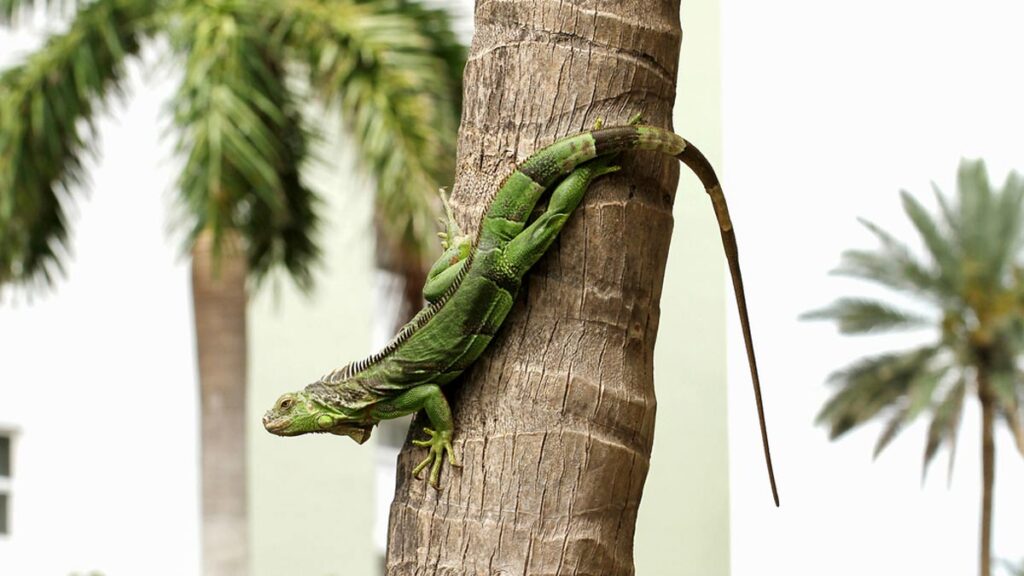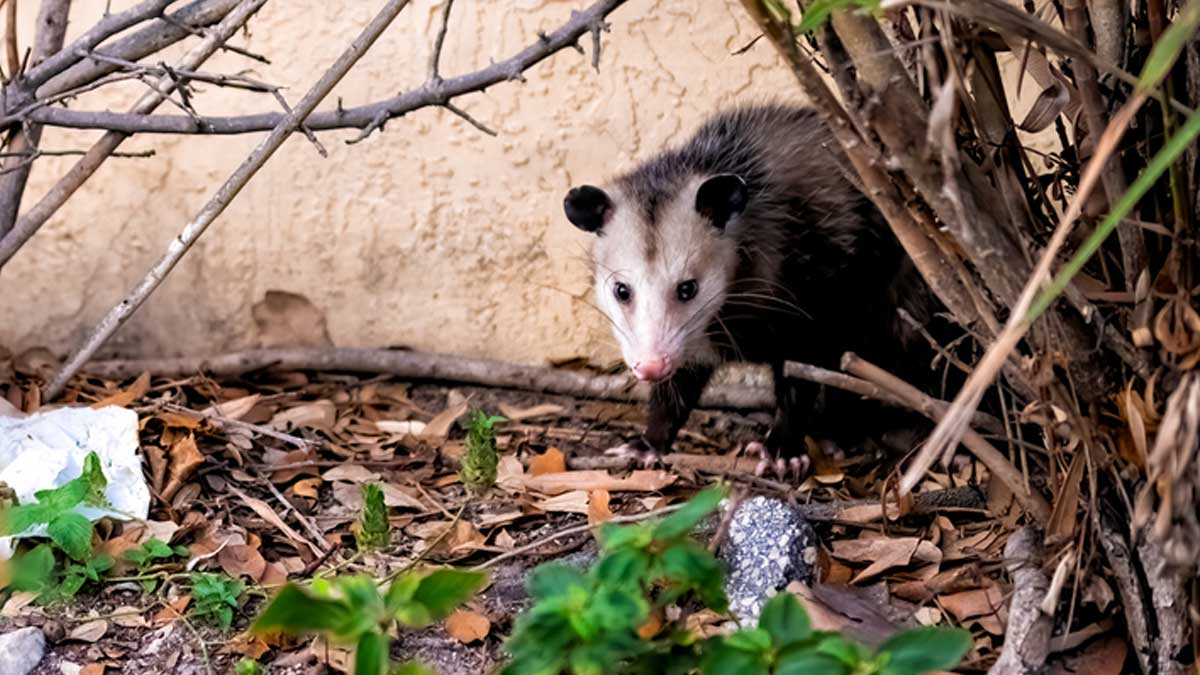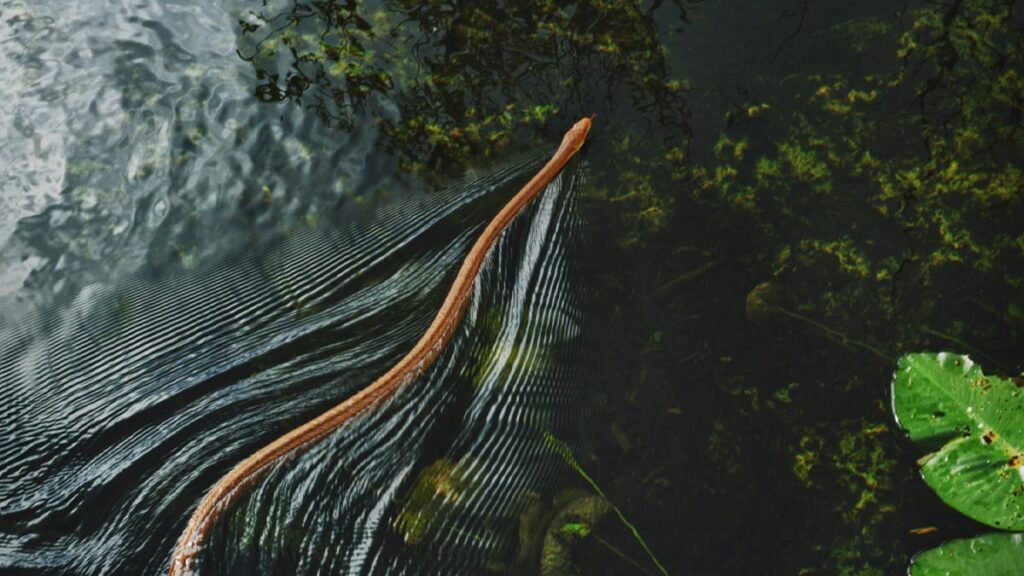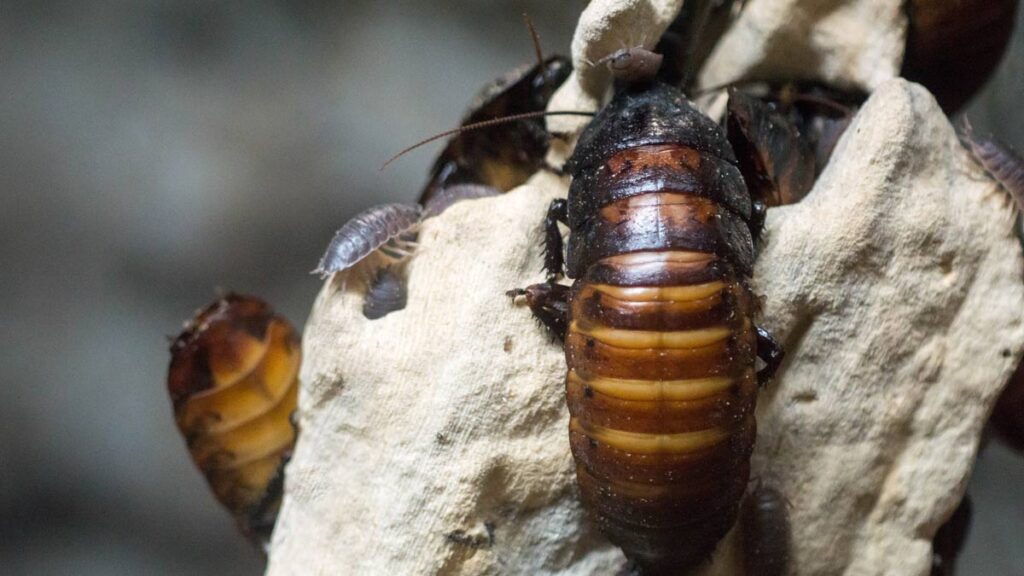
Deterring & Removing Opossums in Florida
A Comprehensive Guide
Updated on: January 2024

Find What You Need
Florida is characterized by having balmy weather and lush landscapes and has become an inviting habitat for a variety of wildlife, including the nocturnal opossum. As the state’s urban areas continue to expand and overlap with natural habitats, more homeowners are encountering these animals on their properties. While opossums play a critical role in our ecosystem, controlling pests and scavenging dead animals, their presence can sometimes lead to conflicts with humans. From rummaging through trash cans to nesting under decks, these creatures often seek out residential areas for food and shelter. As such, understanding their behavior and creating strategies to deter and manage their presence has become important for homeowners who aim to manage a balance between coexisting with wildlife and protecting their property.
Understanding the Opossum: Habits & Ecosystem Role
Opossums, Florida’s only marsupials, have certain attraction factors that draw them to residential spaces such as the availability of food sources. These animals aren’t particular eaters and scavenge various foods ranging from overripe fruits like bananas or berries to household waste. Often brands like “Nature’s Delight” and “Tropicana Organic” have fruit products that attract these creatures if left unconsumed and discarded. Additionally, pet foods, particularly brands like “Purina” or “Blue Buffalo”, if left outside overnight, can serve as an attraction for wandering opossums.
Their habits do vary with Florida’s seasons. While they’re year-round residents, their activity intensifies during the spring breeding season. During this period, you’ll notice increased scavenging as they hunt for more food to sustain themselves and their offspring. As nocturnal creatures, opossums are mainly active from dusk till dawn. Late evening hours, especially between 9 pm and midnight, is when you can expect to see heightened opossum activity and nightly forages.
In the broader Florida ecosystem, opossums play an indispensable role as they help regulate pest populations by feeding on insects, small rodents, and even harmful species like ticks, which subsequently reduces the chances of Lyme disease transmission. Moreover, their scavenging nature helps in cleaning the environment of dead animals and rotting fruits. Through these activities, opossums strike a balance in the ecosystem, ensuring the health and functionality of the environment they inhabit.
Opossums are opportunistic feeders, which means they eat a wide variety of foods. In Florida’s urban environments, they often scavenge overripe fruit, vegetables, and even small insects or animals that might have perished.
Identifying Opossum Presence & Potential Damages
Opossums can be easily detected when their warning signs are understood and promptly identified. However, it is important to understand the impact and potential threats that these animals pose to your home and family.
Signs of Opossums
To detect the presence of opossums, homeowners should be aware of distinctive signs including opossum tracks. Unlike other wildlife, they have an opposable thumb on their hind foot, which makes their tracks look like tiny human handprints. Moreover, overturned garbage cans, especially those without secure lids, frequently indicate a nighttime scavenge. If you’ve recently purchased a trash can from brands like “Rubbermaid” or “Toter”, it’s advisable to secure the lids with bungee cords, which can be bought at local stores or online for around $10 for a pack. Additionally, opossums can leave droppings, which are often mistaken for cat feces but have a tapered end.
Differentiating between opossum and raccoon damage can be a bit challenging. While both can knock over trash cans, raccoons tend to leave behind a bigger mess, often scattering trash over a wider area. Furthermore, raccoons are dexterous and can open containers or packages, while opossums are more likely to rummage through open or easily accessible items.
Damages & Concerns
Opossums, though generally harmless, can cause a few issues for homeowners. Beyond the trash disturbances, they might dig up gardens in search of grubs or worms, affecting plants and decorative landscapes. Occasionally, they’ll take up residence under a shed or deck, where they may create nests using materials found on the property. Brands like “Scotts” or “Miracle-Gro” offer garden repair mixes for around $15-$25 that can help homeowners restore any damage to their lawns or plant beds.
Also while not innately aggressive, opossums can become defensive if they feel cornered or threatened and potentially bite pets or humans which can pose a risk. Moreover, they can harbor other parasites, like fleas or ticks, which can transmit diseases to pets or even humans but are not common carriers of rabies. Regular vet visits and using products like “Frontline” or “Advantage” for pets can help mitigate such risks.
Opossum Deterrence
Opossum encounters can be decreased by using simple and common methods such as utilizing natural repellents, modifying your home landscape, or employing technological devices to increase deterrence.
Natural Repellents
Many homeowners have found success with natural repellents by using a mix of essential oils. Ammonia and garlic have strong odors that opossums dislike, and these can be sprinkled around areas where these creatures frequently visit. A popular repellent spray on the market is “Eco Defense Organic Home Pest Control Spray”, which costs around $20 for a 16 oz bottle. Another effective strategy involves planting certain flora that opossums tend to avoid. Plants such as marigolds, which emit a pungent scent, can act as a deterrent, making them an excellent addition to gardens susceptible to opossum visits.
Landscaping Solutions
Landscaping for opossums, such as reducing hiding or nesting spots, allows for homeowners to make their properties less appealing. This includes keeping shrubbery well-trimmed and elevating woodpiles. Installing gravel or rock beds around potential nesting areas can also discourage digging. For gardens or structures that have suffered damage, it’s helpful to consider soil restoration products like “Good Earth Organic Soil Conditioner” available for about $15 per bag. This product can help rehabilitate areas that opossums have dug up, promoting faster plant growth and healing.
Technological Aids
Technological aids like motion-activated sprinklers, such as the “Orbit Yard Enforcer”, priced at around $70, can be a significant deterrent and increase opossum deterrence. These devices activate when they sense movement, releasing a burst of water, which frightens away opossums without causing harm. Meanwhile, ultrasonic devices, like “TBI Pro Ultrasonic Pest Repeller”, costing approximately $50 for a pack of two, emit frequencies unpleasant to opossums, further driving them away. Both tools have seen varied results, with motion-activated sprinklers generally receiving more consistent positive feedback for their effectiveness in opossum deterrence.
Securing Your Property & Reducing Attraction
Various actions can be taken to protect your property. Securing attractive aspects such as trash cans, installing protective measures against common shelter spots, and understanding the potential of pet interference are all important in decreasing the likelihood of scavenging.
Trash & Feeding Concerns
An effective way to deter opossums is to manage the primary attraction of food. Secure trash cans, especially those brands like “Behrens” or “Suncast”, with tight-fitting, locking lids. If your bin doesn’t have a lock, consider using heavy-duty bungee cords, available at hardware stores for roughly $10-$15 for a set, to seal them shut. Additionally, placing a weight, like a brick or a heavy stone, atop the lid can further dissuade opossums. While it might seem tempting to divert opossums by feeding them in a specific spot, this is ill-advised. Not only does it encourage their return, but it can also lead to increased numbers over time.
Protecting Home Structures
Opossums often seek shelter in quiet, dark places, such as under decks or homes. To prevent this, homeowners should consider installing a wire mesh or lattice, like the “GardenCraft Rolled Mesh” that costs about $30 for a 5 x 10-foot roll, around the base of these structures. It’s important to bury the bottom of the mesh at least a foot deep to prevent digging. Vent covers or chimney caps, such as those from “HY-C Company”, which range from $40 to $150 depending on size and material, can also deter opossums from making a home in less conventional areas.
Pets as Deterrents
The presence of pet dogs can act as a deterrent to opossums as the scent and activity of a dog often discourage these nocturnal visitors from approaching your home. While larger breeds like German Shepherds or Labradors can be more intimidating, even smaller breeds can be effective if they’re active and vocal. However, homeowners should be cautious about potential confrontations between pets and opossums, especially during the latter’s breeding season, when they might be more defensive. Regular nighttime patrols with a dog can reduce opossum visits but always ensure pets are safely contained or supervised to avoid any unfortunate encounters.
Humane Relocation & Legal Considerations
In approaching opossum relocation and infestations, it is essential to understand the regulations and risks associated with these processes and when to employ professional help.
Relocation Methods
When it comes to humane relocation, live trapping is the most recommended method. Live traps, like those from “Havahart”, offer a range of sizes suitable for opossums and are available at many local stores and online retailers for approximately $40 to $70. Once trapped, it’s important to cover the cage with a cloth or tarp in order to reduce the animal’s stress. When relocating an opossum, always ensure it’s done within a short distance, ideally less than a mile from the capture site, to avoid placing the animal in an unfamiliar territory where its survival might be compromised.
Engaging Wildlife Professionals
While DIY measures can sometimes be effective, in recurring or complex situations, it’s best to engage wildlife professionals. If opossums are repeatedly entering a home, causing significant property damage, or showing signs of illness, it might be time to call in the experts. Companies like “Critter Control” or “Wildlife Rescue” specialize in humane animal removal and often provide services that not only address the immediate problem but also help prevent future invasions. The cost for professional opossum removal in Florida typically ranges from $150 to $300, depending on the complexity of the situation.
Legal Aspects
Florida has specific laws and regulations concerning the relocation of wildlife. Under Florida’s Fish and Wildlife Conservation Commission (FWC) guidelines, homeowners can trap nuisance opossums but must release or euthanize them humanely within 24 hours of capture. Relocating trapped opossums to other areas, especially public lands, without appropriate permits can lead to legal complications. Always familiarize oneself with local regulations or consult with a licensed wildlife remover to ensure all actions align with state laws.
Precautions & Community Collaboration
While it’s important to remember that opossums are more afraid of humans than we are of them, caution is essential during an encounter. Always wear gloves, such as “Atlas Nitrile Tough Gloves” available for around $7 a pair, when attempting to handle or move objects where opossums might be hiding. If you suspect an opossum is present, use a flashlight with a long beam range, like the “Anker Bolder LC90”, priced at about $30, to illuminate dark corners without getting too close. Avoid cornering or making sudden moves towards them, as this can provoke a defensive response. Remember while opossums are not typically aggressive, they can bite if they feel threatened.
A community-driven approach can amplify the results of individual efforts. Neighbors can form a community watch group, organizing regular checks for potential opossum attractants, like open garbage bins or food sources. Pooling resources to bulk buy deterrents, such as motion-activated sprinklers or ultrasonic devices, can also be cost-effective. Sharing information, perhaps through community apps like “Nextdoor”, can help spread knowledge about which deterrence methods are working best locally. Hosting informational sessions, possibly with a local wildlife expert or animal control officer, can educate residents, ensuring that everyone is on the same page when it comes to humanely and effectively managing opossum activity. This shared responsibility not only reduces individual burdens but also creates a more holistic and sustainable approach to opossum deterrence.
Take Away
In Florida, while opossums play a valuable role in the ecosystem, their proximity to homes can sometimes lead to conflicts. By understanding their habits and adopting informed, humane deterrence measures, homeowners can manage opossum activity effectively. It’s essential to strike a balance between coexistence and proactive management, ensuring both a harmonious relationship with local wildlife and a peaceful living environment.


